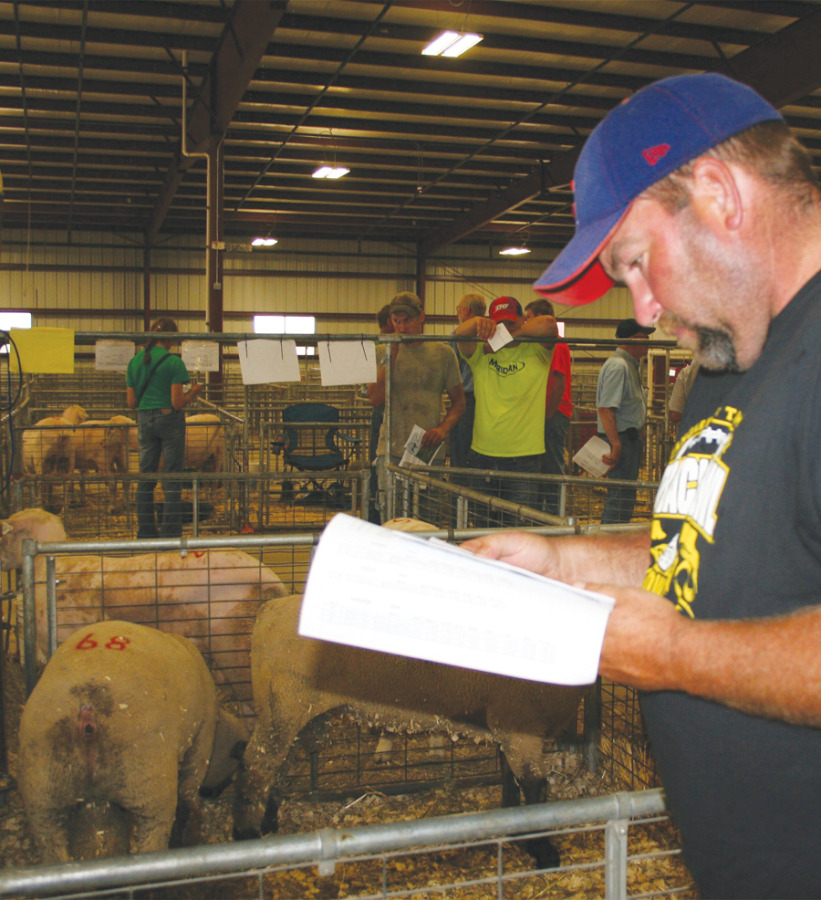Growing the Industry Through Genetics
Terri Queck-Matzie
Special to the Sheep Industry News
ASI says “Let’s Grow.” The campaign is designed to lead the industry into the future through innovation and sustainability. But how does a seedstock or commercial producer get from point A to point B?
One of the answers, according to the Let’s Grow initiative and the Sheep Industry Roadmap is: genetic improvement. That’s where the National Sheep Improvement Program comes in.
 “Quantitative genetics has the most potential to get us where we need to go,” says ASI Vice President Mike Corn of Roswell (N.M.) Wool. Corn is also chairman of the Let’s Grow committee. “The genetics are out there. We have to make the best use of them. Producing more with less is key to any industry these days, and utilizing our genetics to their full potential is how we will grow.”
“Quantitative genetics has the most potential to get us where we need to go,” says ASI Vice President Mike Corn of Roswell (N.M.) Wool. Corn is also chairman of the Let’s Grow committee. “The genetics are out there. We have to make the best use of them. Producing more with less is key to any industry these days, and utilizing our genetics to their full potential is how we will grow.”
It’s all about the EBV
“NSIP is the vehicle, but it’s the estimated breeding values that are the tool for growth,” explains Reid Redden, Ph.D., sheep and goat specialist with Texas A&M Agrilife Extension and chairman of the NSIP board of directors.
Estimated Breeding Values are a science-based, industry-tested measurement of heritable traits that predict genetic performance. An animal’s value is assessed based on its performance data and pedigree. And breeding decisions can be targeted to highlight specific needs and goals.
Used in other forms of livestock production for decades (EPDs, or Expected Progeny Differences, in cattle for instance), EBVs allow producers to choose genetics that can best enhance their operations’ production goals.
“This technology has been out there for 25 years,” says Redden. “We’re behind the times on implementation. We have some catching up to do.”
In fact, he suggests sheep producers who would like to learn more ask their beef producer neighbors to explain. Coming late in the game may have its advantages.
“We can see the mistakes others have made,” says Corn. “It’s pretty clear now how to use this technology. We can just start in.”
So how do you get started?
“First,” says Redden, “seedstock producers need to commit to enrolling in the program.”
Enrollment is followed by data collection and submission, then using that data to make breeding decisions that benefit customers and industry needs.
“Understand, simply enrolling in the program does not automatically mean you have better sheep,” he cautions. “You have to use that data to improve the next generation.”
Next, he says, the commercial producer needs to demand EBVs from seedstock operations that supply breeding animals. If the commercial producer continues to buy sheep without EBVs, the program will not be successful and will fail to improve the genetic potential of the U.S. sheep flock.
Corn says once commercial producers become familiar with the data, then start getting post-harvest feedback from the packers, there will be no turning back.
“I’ve seen them at the sales with the data. Their papers are all colored and scratched up,” Corn says. “They’re hungry for that information.”
Birth weights, weaning weights, lambing rates, loin eye size, wool characteristics – all are sifted through, contemplated and judged for relevance in the commercial herd.
Leaving money on the table
“It doesn’t take any more space or nutrients to raise sheep with superior genetics than those without,” says Corn, “but the benefits at the end pay off in a huge way.”
Corn is in the wool game, and fine wool with a staple length of three-plus inches compared to a medium grade with a 2.75-inch staple means more profit for the producer. And that can be accomplished through better genetics.
Likewise, producing more meat for hungry consumers can be accomplished though the use of EBVs. The U.S. imports nearly 50 percent of lamb consumed – a number that is simply not acceptable to those on industry planning committees.
ASI Executive Board member Susan Shultz, of Bunker Hill Farm in DeGraff, Ohio, sits on the Let’s Grow committee as well as chairing the Roadmap Product Improvement committee; her husband, Bill, is on the NSIP board. Both see room for improvement.
“We need to increase productivity and profitability and one of the primary ways to do that is through genetic improvement,” says Shultz. “Using NSIP EBVs can increase lambing rates. We can breed specifically for that.”
Redden says Montana producers have increased lambing rates in the Targhee breed by roughly 10 percent by using the top 25 percent of rams on the Western Range Index. An index is a calculated mix of trait data designed to simplify selection. While Targhees are primarily focused on wool production, maternal farm flock breeds have seen similar results. Midwest Polypay breeders have seen a 20 percent increase in weaning rate by using the top 25 percent of rams on the U.S. Maternal Index.
Shultz is aware the American consumer expects a consistent, quality product – another goal that can be best met through the use of the right genetics.
“We have a responsibility to provide an enjoyable eating experience each and every time,” she says. “If we’re using the best genetics, we can produce lamb that we are proud to put on a plate.”
Redden says sheep bred for steady, consistent growth can hit a target lamb meat market that suits consumers and brings the best prices for producers.
“It’s not just about bigger is better. In the Targhee breed they use an index that gives a positive value to weaning weight, and a negative value to yearling weight,” he adds. “It’s about controlling the growth.”
Learning a new way
Shultz says the key to bringing producers – both seedstock and commercial – on board with industry goals and new technology is education. The Let’s Grow initiative is in the midst of its second round of grant funding, with many funded projects focused on spreading the word about the benefits of quantitative genetics.
Redden says the resources for producers wanting to learn more about genetic improvement are plentiful.
“Contact NSIP, of course, or your local extension agent. If your local agent can’t answer your questions, they will find out or forward you to your regional or state specialist.”
Or find any one of several upcoming webinars and seminars scheduled through Let’s Grow by visiting GrowOurFlock.org.
“I’m really impressed with the efforts we’ve seen and the cooperation from all aspects of the industry in trying to improve our product, and the interest in moving forward,” says Shultz. “Everyone’s working toward the same goal here – doing what needs to be done to grow the U.S. sheep industry.”
Redden says the need to embrace the new age simply cannot be overstated. “On both the individual producer and industry-wide levels we need this technology to be competitive and profitable – and sustainable for future generations.”
More information on NSIP can be found at NSIP.org.


